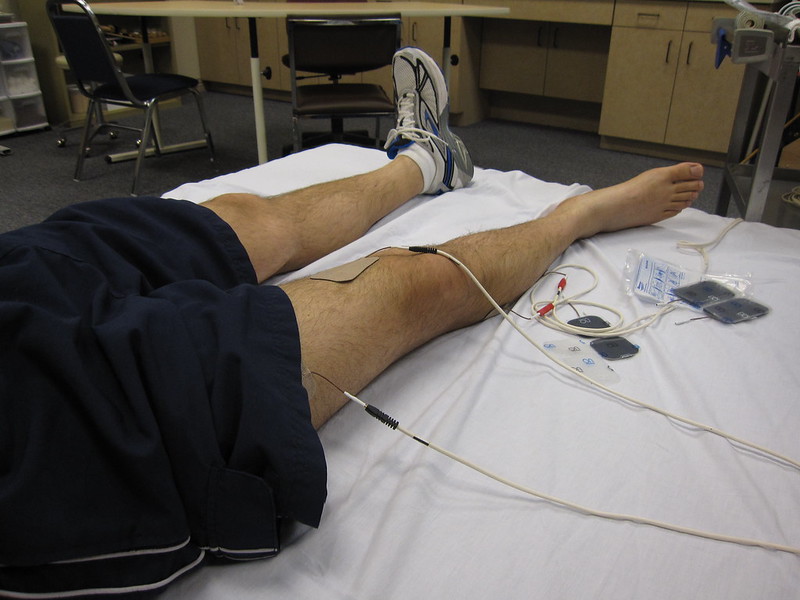Utility of Neuromuscular Electrical Stimulation to Preserve Quadriceps Muscle Fiber Size and Contractility After Anterior Cruciate Ligament Injuries and Reconstruction
Toth MJ, Tourville TW, Voigt TB, Choquette RH, Anair BM, Falcone MJ, Failla MJ, Stevens-Lapslaey JE, Endres NJ, Slauterbeck JR, Beynnon BD. Am J Sports Med. 2020 July 6. doi: 10.1177/0363546520933622.
https://journals.sagepub.com/doi/abs/10.1177/0363546520933622
Take-Home Message
Neuromuscular electrical stimulation started soon after an ACL injury limits quadriceps atrophy and functional declines in slow-twitch muscle fibers.
Summary
Patients often experience suboptimal outcomes after anterior cruciate ligament (ACL) reconstruction due to muscle atrophy and weakness. Neuromuscular electrical stimulation (NMES) may limit muscle atrophy and weakness after surgery, especially if started closer to periods of disuse of injury. However, clinicians rarely prescribe NMES likely due to inconclusive research findings. Hence, the authors conducted a randomized, sham-controlled, blinded trial to determine whether NMES, started shortly after an injury and maintained through 3 weeks after ACL reconstruction, can preserve muscle size and function. They also explored “whether early NMES use enhances whole muscle strength at later time points”. The authors enrolled 25 patients who were 18-50 years old, had a BMI < 35 kg/m2, had an acute ACL rupture (<3 weeks from injury), and were scheduled to undergo ACL reconstruction. Participants were randomized and taught how to use either an NMES device (intervention) or a simulated microcurrent electrical nerve stimulation (sham) device. Study staff told participants to use the device at home for 60 minutes/day, five days/week, from within three weeks of their injury until three weeks after surgery. Before surgery, the authors measured bilateral muscle strength (isometric and isokinetic) and physical activity (via accelerometer). At three weeks post-surgery, bilateral biopsy samples were taken from the vastus lateralis muscles and computed tomography was performed. The authors used the biopsy to assess muscle fiber size and contractility. The computer tomography assessed thigh muscle cross-sectional area. Physical activity was measured again between 2 and 5 months after surgery. Finally, bilateral muscle strength and size were quantified 6 months after surgery. Twenty participants (11 NMES, 9 sham) completed the 3 weeks of device usage and 16 (9 NMES, 7 sham) completed all 6 months of the study. ACL injury and reconstruction caused muscle atrophy, regardless of group. However, at 3 weeks after surgery, the NMES group had less muscular atrophy (especially in fast-twitch fibers) and better contractility in slow-twitch muscle fibers relative to the sham group. The groups did not differ in physical activity levels or strength 6 months after surgery.
Viewpoints
The authors found that muscle cross-sectional area and muscle fiber function decrease after ACL injury and reconstruction. Clinicians may prescribe NMES soon after injury and surgery to limit both fast-twitch muscle fiber atrophy and functional declines in slow-twitch muscle fibers. However, these benefits failed to translate to benefits in strength or physical activity. Two reasons may explain this failure: 1) only 16 of the initial 25 participants completed their 6-month assessments, and 2) NMES may be needed for more weeks after surgery. Despite this, the ability of NMES to limit fast-twitch fiber atrophy may help patients return to play safely and warrant larger trials. The risks of using NMES are low, and the possible benefits and ease of learning to use the device at home make it an appealing adjunct to therapy after an ACL injury.
Questions for Discussion
How do changes in frequency and duration of NMES use affect these outcomes? What can clinicians do to ensure that NMES gets prescribed soon after an injury?
Written by: Ryan Paul
Reviewed by: Jeffrey Driban
Related Posts
Does Electrical Stimulation Improve Patellofemoral Pain Syndrome Outcomes? The Results May be Shocking!
TENS to Treat Knee Pain Induced Quadriceps Inhibition?!
ACL Injuries Are Getting on My Nerves


